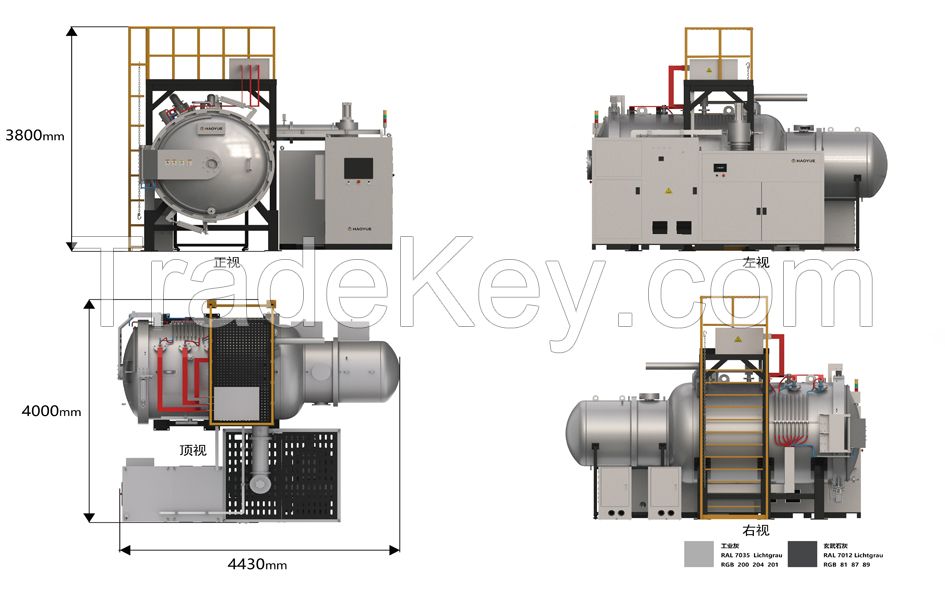Vacuum quenching refers to the smooth quenching of parts. The
quenching and cooling of parts are carried out in the vacuum
furnace, and the quenching medium is mainly gas (such as
inert gas), water and vacuum quenching oil. Vacuum quenching
has been widely used in the quenching of various steels,
alloy tool steels, high-speed steels and stainless steels, as
well as the solution treatment of various aging alloys and
hard magnetic alloys.
There are two kinds of quenching in vacuum: gas quenching and
liquid quenching. Gas quenching is when the workpiece is
heated in a vacuum and then cooled by high-purity neutral gas
(such as nitrogen) in the cooling chamber. High-speed steel
and high carbon and high chromium steel are suitable for gas
quenching. Liquid quenching is to heat the workpiece in the
heating chamber, move it to the cooling chamber, fill it with
high-purity nitrogen, and immediately send it to the
quenching oil tank for rapid cooling. If high surface quality
is needed, tempering and precipitation hardening after vacuum
quenching and solution heat treatment should still be carried
out in a vacuum furnace.
1. Especially suitable for carburizing steel, stainless steel
and air-cooling steel, more suitable for small holes, and
blind holes.
2. Stainless steel can achieve excellent effects without
removing passive film.
3. No black structure, reduce fatigue sources, greatly
improve the life of parts.
4. It can be carburized at medium temperature and high
temperature and high speed with high efficiency.
5. Precise vacuum low-pressure carburizing process, stable
operation, good reproducibility.
6. The one- intelligent control system can accurately
control the surface carbon content, and the carburized layer
depth is uniform.
Vacuum Gas Quenching Medium:
The cooling rate of vacuum air quenching is related to the
type of gas, gas pressure, flow rate, furnace structure and
loading condition. Available gases are Ar, He, H, and N,.
Assuming that the heat transfer rate of air under the same
conditions is 1, then Ar is 0.*0, He is 6, H is 7, and N2 is
0.*9.
Specifications
A Vacuum Gas Quenching Furnace is applied for quenching
high-speed tool steel, measuring vacuum hardening and cutting
steel, tool steel and other alloy steel, with a convection
heating function, which can achieve the process of step
hardening, isothermal quenching, but also tempering,
annealing and other heat treatment process. Ultimate
pressure: cooling gas,6Bar or *0Bar. The control system was
controlled by PLC, temperature was controlled by an
intelligent temp controller, accurate control, and high
automation. Users can choose auto or manual undisturbed
switching to operate it, this furnace has abnormal conditions
and alarming function, easy to operate. The environmental
protection performance of vacuum furnaces has been improved,
with maintenance cost saving, energy cost savings.
Numbering Model Working Zone size(mm) Capacity(kg) Heating
material Cooling Gas HeatingPower
(KW) Max temperature (℃) Temperature
uniformity(℃) Limit vacuum degree (PA) Air
cooling pressure (bar)
VHG***6 VHGgr**0/*0/******0 **0x**0x**0 **0 Graphite N2/Ar *0
***0 ±5 6x***1Pa *0
VHG***9 VHGgr**0/*0/******0 **0x**0x**0 **0 Graphite N2/Ar
**0 ***0 ±5 6x***1Pa *0
VHG****2 VHGgr**0/*0/*******0 **0x**0x***0 ***0 Graphite
N2/Ar **0 ***0 ±5 6x***1Pa *0
Remark: The working zone of equipment could be customized
based on the customer's production.
The Vacuum Gas Quenching Furnace produced by Haoyue is a
high-quality product for the vacuum air quenching process of
the tool and mold. Good temperature control accuracy and
uniformity ensure the effective progress of the vacuum air
quenching process. Haoyue specializes in the manufacture of
vacuum furnaces, has more than ten years of relevant
experience, and has a good reputation in the field of vacuum
furnace manufacturing. The product line includes vacuum
annealing furnaces, vacuum oil quenching furnaces, vacuum
brazing furnaces, etc., widely sold in developed and
developing countries.

